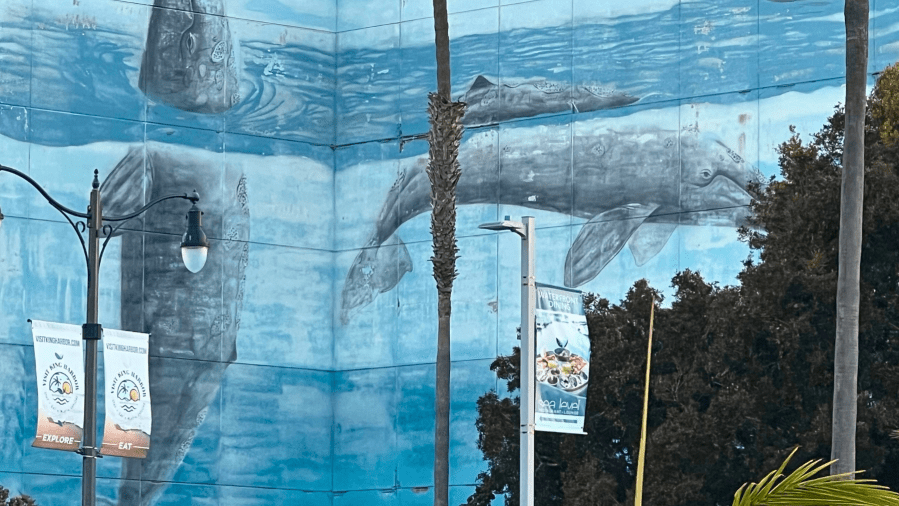The greater Los Angeles area is home to some of the most astounding murals in the nation.
These works of art, permanent or temporary, pay tribute to late sports legends such as Kobe Bryant and Fernando Valenzuela. Others have deeper cultural meaning, including The Great Wall of Los Angeles, which highlights diversity. Even the famed “Hollywood Cat,” P-22, has one.
Many consider Los Angeles to be “the mural capital of the world,” and each painting shares a point of view or serves a purpose – and sometimes both.
That’s the case with one of the largest murals in the region.
For decades, anyone who has visited King Harbor in Redondo Beach has been greeted by a 100-foot-tall, 586-foot-long painting of gray whales swimming in the deep blue sea. “Gray Whale Migration” is the vision of renowned local artist Robert Wyland, whose reproductions of sea life can also be found in Long Beach and Laguna Beach, as well as in cities around the globe.
His mural on the Long Beach Arena once held the Guinness record as the largest in the world.

“My life is not only about the art, but conservation,” Wyland told the Palos Verdes Pulse. “My ultimate goal is to leave a legacy that inspires people of all ages.”
Wyland also created the Wyland Foundation in 1993 to highlight the need to protect marine ecosystems. His lifelong commitment to conservation makes the Redondo Beach mural even more poignant – for a unique reason.
Behind the mural is a 49-acre natural gas power plant that served the region’s electricity needs for nearly 70 years. Wyland’s mural was installed in 1991 to partially obscure the unsightly stacks and pipes.
The AES power plant ceased operations at the end of 2023, but the site’s redevelopment has been mired in protracted legal disputes.
Developer Leo Pustilnikov purchased the property in 2020 for roughly $150 million, intending to build housing, a hotel, shops, restaurants and office space on the prime piece of real estate, which is mere footsteps from the Redondo Beach marina. However, the city council rejected the project, citing local zoning laws.

“Right now, the site is only zoned for public utility as a conditional use or as a public park,” Redondo Beach Mayor James Light recently told KTLA 5 News. “I prefer as much park as possible.”
What ultimately becomes of the site rests on the outcome of a bankruptcy filing by the developer and the courts, and the mural’s fate also hangs in the balance.
Steve Creech, president of the Wyland Foundation, said they would like to see the property returned to its natural state rather than become a mixed-use development.
“We’d love to be part of something that honors what the mural has meant to the people of the South Bay and elevates the conversation about protecting our environment on a much bigger scale,” Creech told KTLA. “Whether it’s a new landmark, a reimagined space, or something that brings even more people together in support of ocean conservation.”
In the past, Pustilnikov expressed interest in preserving some of the murals for the redeveloped power plant site – if his project were to move forward. However, a spat with the Wyland Foundation in 2020 led to his threatening to destroy it.
For now, the mural remains an integral part of Redondo Beach’s skyline. Whatever the outcome of the legal cases, Creech would like to see Wyland’s work and mission remain a focal point.

“We’d love to be part of something that honors what the mural has meant to the people of the South Bay and elevates the conversation about protecting our environment on a much bigger scale, whether it’s a new landmark, a reimagined space, or something that brings even more people together in support of ocean conservation,” he said.
